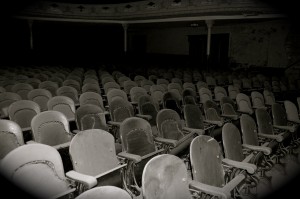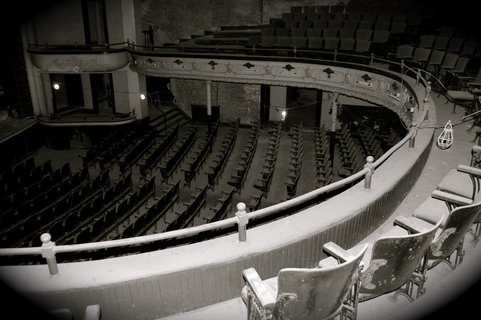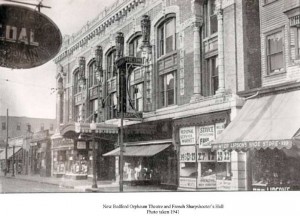
The Orpheum opened its doors to New Bedford on April 15, 1912, and proceeded to flourished throughout the decades that followed. Originally created by an organization known as The French Sharpshooters Club, The Orpheum not only hosted live theatre productions, but also showed popular films and newsreels. Its grand ballroom held dances, receptions, and socials, all while The French Sharpshooters themselves were training World War II recruits in the buildings very own rifle range. Unfortunately, as the fifties came to a close, so did the livelihood of The Orpheum.
Growing up in the New Bedford area, I can remember driving past The Orpheum countless times and always wondering about its purpose, and its past. So when the opportunity to explore this mysterious building presented itself to me, I jumped at the chance. I was fortunate enough to be invited to tour the building by Mr. Lance Gunberg, president of O.R.P.H, Inc., a non-profit organization dedicated to reviving The Orpheum.
In the brief amount of time I spent with him, Mr. Gunberg filled my head with passionate explanations of what once was, and brilliant ideas for what could be. I was smitten with his dreams for this decaying piece of New Bedford’s history. Never have I met a man so devoted to his organization, and it is because of his infectious attitude that I am pleased to share with you his eloquent words.
Amanda: I would like to start out with a little back story about the Sharpshooter’s Hall, as well as The Orpheum. Could you please tell me a little bit about the history of the building and its place in historical New Bedford.
Lance: The French Sharpshooter’s Club was a French Canadian men’s benevolent organization consisting of rifle marksman who would meet and compete with similar groups and organizations throughout the East Coast of the United States, as well as Canada. The group would help French Canadian immigrants (who at one time made up over a quarter of New Bedford’s population) in times of need.
As their ranks began to grow in number, the organization divided into two distinct groups: Guard Number One and Guard Number Two, or the North End Branch and the South End Branch. Over time, the organization expanded and decided to build a community center and theatre that could be used by all.
The French Sharpshooter’s Hall, or Salle Francs-Tireurs, began construction at 1005 South Water Street in 1910, and would ultimately take 2 years to construct, finishing in 1912. It was designed in the Beaux-Arts Style by famed New Bedford architect, Louis Destremps. Destremps designed a beautiful façade, complete with four muse heads in relief, as well as other ornate relief details finished in glazed terra-cotta on a red brick background. The top of each muse head was adorned with a Greek-style torch that would illuminate the face of the building at night. The building housed, among other things, office space, meeting rooms, assembly rooms, a gymnasium, a grand ballroom, a sharpshooters firing range and of course, the gorgeous Orpheum Theatre.
In its original configuration, The Orpheum was built as a 1,500 seat Vaudeville house. The theatre also began to show films when movies eventually eclipsed live performances in popularity. The theatre was part of the original Keith-Albee Circuit and featured many great performers during its heyday. It opened the very same evening the RMS Titanic was steaming toward her tragic end.
What exactly is the organization known as the Orpheum Rising Project Helpers, or O.R.P.H, Inc.,? And why did you decide to not only get involved, but eventually become its president?
Lance: O.R.P.H., Inc. is a non-profit organization that was incorporated to preserve the Orpheum Theatre. The group holds fundraisers and tours of the theatre to help raise awareness as to the condition of the building and what the hall meant to the city of New Bedford and the community at large. It was after a fundraiser at Gallery X, titled Eye on the Orpheum, that featured a gallery of photographs taken by local photographers, as well as artifacts from its past. I had just completed my short film, Orpheum Rising, and it premiered during that show.
Shortly after, O.R.P.H., Inc.’s original president, Chuck Hauck, felt it was time to step down after successfully heading the group for nearly six years. I was approached by a number of our members who asked me to consider taking the helm. Shortly thereafter, I was voted in as the new president. We also have all new officers: The vice president’s position, originally held by Ricardo Santos, has been filled by Frank C. Grace. The secretary’s position, formerly held by Colin Williams, is now filled by Shannon Farrell and the treasurer’s position, which was also held by Colin Williams, was filled by Rev. Russ Chamberlain.
How is O.R.P.H, Inc raising money to fund the theaters restoration?
Lance: We are currently raising money and awareness by holding fundraisers and occasional tours of the building. Although the funds raised are used primarily to keep our organization running, by means of community outreach materials, insurance policies, attorney fees and other costs associated with running a non-profit organization, we are not currently raising funds for restoration as of this time because the theatre is not owned by our group.
Is it possible for local residents to get involved with this project. If so, how?
Lance: Yes. We would love to have the community involved in our project! We are always looking for new members, as well as volunteers and support people for our various endeavors. In the future, if our efforts are successful, we will need a huge outpouring of support, volunteerism and donations to keep our efforts afloat. Anyone interested in joining O.R.P.H., Inc., or for further information about us and the history of the building, please visit: www.orphinc.org. The documentary film can also be viewed on the website as well.
What is the current status on this project?
Lance: Currently, our attorney is in talks with the attorney of the owner of the building to purchase the theatre portion of the building. This can be done by working out a condominium contract, thereby giving our organization the legal documentation we will need in order to move forward with the restoration of the theatre and its surrounding ancillary rooms and the grand ballroom. Also, a formal agreement is necessary to begin securing grant funding on the state and federal level.
Finally: If O.R.P.H, Inc. does secure ownership of Sharpshooter’s Hall/The Orpheum, what do you envision for its future?
Lance: We are very aware that many in New Bedford think we plan to become another performing arts center, like the Zeiterion Theatre, but that is not the case.
Part of our outreach is to educate the public about what our ultimate goal is for the theatre. We envision creating a community theatre that would be utilized by local theatre groups, to stage their productions. We would also love to have local schools use the facility to stage their productions as well. It would be a great teaching tool, as it is the second oldest Orpheum Theatre in the country and is a prime example of an early American Vaudeville and movie venue with a rich history. The ballroom would be rented out for dances, receptions, fundraisers, etc. The ancillary rooms will be utilized by local multi-cultural community groups and organizations for meetings, presentations and fundraisers.

Of course, there is much work to be done and the support of the community at large, as well as other civic and preservation organizations, will become even more important in the near future. Far too often we have heard that ours is a pipe dream; an impossible project that has no chance for success. The way we look at is, if nothing is done, nothing happens. There is always the possibility of failure with any venture in life, large or small. However, doing nothing at this point just guarantees that failure.
The reconstruction of Route 18 is now underway, and it will eventually make its way to the South End of New Bedford. The French Sharpshooters Hall sits a few feet from the edge of the current highway. If we can begin to get funds coming in and get work started on rehabilitation, we feel that the construction that will eventually be done on that portion of the highway, will benefit the infrastructure of that area (of the Orpheum Theatre). By creating a more people-friendly space and by reconnecting the neighborhoods that were cut off by its original design, we will once again return the French Sharpshooters Hall and Orpheum Theatre to the residents of those neighborhoods.
Perhaps even portions of the original “Orpheum Plaza” plan, that can be viewed on our website and were introduced by our organization many years before the proposed reconstruction of Route 18 began, will be incorporated into the final design. We feel that the time is right to take advantage of this opportunity and to see it become a reality. One thing we do know. If the city loses this historic theatre, it loses an integral part of its very rich and diverse past and a piece of true American history, that can never be recreated.
Thanks for your time Lance.
Today, The Orpheum is much like a sleeping giant. The former bustling beauty now lays dormant, as if frozen in time. The theatre’s interior is caked in dust, old oil canisters sit on the floor of the screening room, and broken furniture is carelessly strewn about. Yet the entire building still feels alive, practically humming, like a social ghost just waiting for its life to be restored. And Mr. Gunberg is just the man to do it. His enthusiasm and drive remind me of an anonymous quote, which I feel perfectly describes the situation at The Orpheum.
“A pessimist is a person who is always right but doesn’t get any enjoyment out of it, while an optimist, is one who imagines that the future is uncertain. It is a duty to be an optimist, because if you imagine that the future is uncertain, then you must do something about it.”
[nggallery id=21] New Bedford Guide Your Guide to New Bedford and South Coast, MA
New Bedford Guide Your Guide to New Bedford and South Coast, MA








Great job on the article! I really like the photographs too. Thanks so much for taking the time and doing OPRH Inc. and the building justice.
Thank you, Frank. It was truly an experience. I hope one day everyone will be able to enjoy The Orpheum as it was meant to be enjoyed. I wish ORPH Inc. the best of luck with their endeavors.
I remember going there as a child w/ my brother and a childhood friend. I was 6 years old, my brother 2, and our friend 4. Our mother’s would drop us off to go shopping an we would watch a double feature, a cartoon and some Beach Blanket Bingo sort of film. My how times have changed. 😉
This is certainly a worthwhile and exciting project. I think the community will rally to support it.
What a beautiful facility, I can’t believe all of that history is just sitting inside the building waiting to used! That would be a great thing for NB
Oh, it must have been so gorgeous. I can only imagine what it must have been like.
I wonder if my grandparents had been to the Orpheum or my parents. Thank you all for being so inspired that you have given your time and money to save this beautiful piece of history.
great article i loved it!!!!!
It was where Saturday afternoons were spent. Cartoons, Serials, News, Westerns movies (Durango Kid, Roy Rogers, Hopalong Cassidy, ,etc) all for 12 cents (or the large sum of 25 cents if you were over 12 years old…but you could usually fake it until you were about 14).
Usually walked, with friends, to the Orpheum from South Dartmouth – about 1 1/2 miles. Great fun…great memories. Can remember exactly where we sat in the balcony.
Maybe open it up as a recreation room for kids to keep them off the street and getting in trouble.